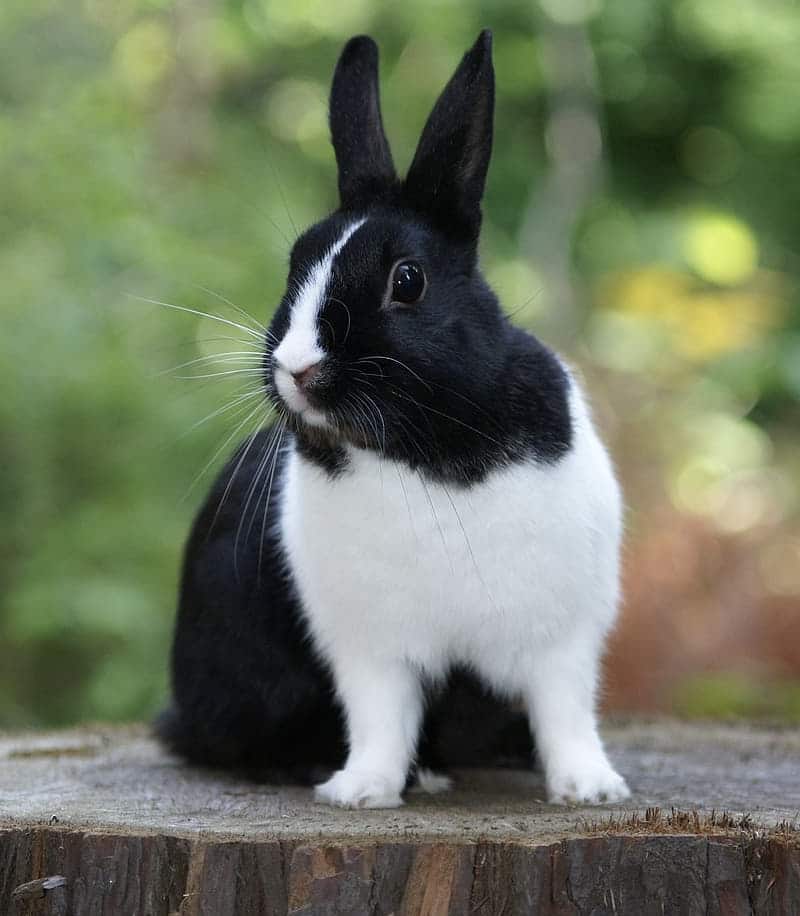
Breed facts
Size
1,8-2,49 kg
Look
Very distinctive black and white coloring. They have dark ears and bottoms and white shoulders, belly, and front legs—plus, a wedge of white fur up the front of their face.
Personality
Calm and gentle but will easily get depressed if left cooped up too long. Very sociable.
Grooming
Sheds heavily in the summer months. Needs to be able to run often.
Behavior With Children
Very calm and friendly with children.
Health Concerns
No notable health concerns beyond regular rabbit care.
Life expectancy
5–8 years
Breed facts
Size
1,8-2,49 kg
Look
Very distinctive black and white coloring. They have dark ears and bottoms and white shoulders, belly, and front legs—plus, a wedge of white fur up the front of their face.
Personality
Calm and gentle but will easily get depressed if left cooped up too long. Very sociable.
Grooming
Sheds heavily in the summer months. Needs to be able to run often.
Behavior With Children
Very calm and friendly with children.
Health Concerns
No notable health concerns beyond regular rabbit care.
Life expectancy
5–8 years
Breed facts
Size-4 to 7,5 kg
Temperament-calm and friendly with a playful personality
Grooming-they need to be groomed frequently due to their long, double coat that mats easily
Behavior with children-they get along very well with children and babies due to their kind, friendly, and fun personality
Health Concerns-Brachycephaly-it is a malformation of the skull due to their breeding; heart disease, eye issues (caused by eye irritations and excess discharge); hair issues (they don't have fur, they have long hair with can tangle easily); ear issues( ear infections); skin sensitivity (allergies) and they also might develop a stomach sensibility due to their selective appetite
Life expectancy-10 to 16 years (the oldest recorded Shih Tzu has lived 23 years)
”The Dutch rabbit was developed in England, despite its name implying that it originated in the Netherlands. Rabbits were imported weekly from Ostend, Belgium, for the meat market in England during the 1830s.”
”A breed known as the Petit Brabançon, which originated in Brabant, Flanders, was among these rabbits. In paintings from the fourteenth century, the Petit Brabançon can still be seen. This ancient breed is the genetic ancestor of the Dutch rabbit. The Petit Brabançon exhibited Dutch markings frequently, and breeders in England selected those with uniform patterns, resulting in the breed we know today."
Also,the color gold was added to the American Rabbit Breeders Association in U.K. as a standard of perfection at the convention from 2021.
They are a peaceful and placid species that make excellent pets, particularly for families with children. They don't mind being handled,being also easy to train.
”The Dutch rabbit was developed in England, despite its name implying that it originated in the Netherlands. Rabbits were imported weekly from Ostend, Belgium, for the meat market in England during the 1830s.”
”A breed known as the Petit Brabançon, which originated in Brabant, Flanders, was among these rabbits. In paintings from the fourteenth century, the Petit Brabançon can still be seen. This ancient breed is the genetic ancestor of the Dutch rabbit. The Petit Brabançon exhibited Dutch markings frequently, and breeders in England selected those with uniform patterns, resulting in the breed we know today."
Also,the color gold was added to the American Rabbit Breeders Association in U.K. as a standard of perfection at the convention from 2021.
They are a peaceful and placid species that make excellent pets, particularly for families with children. They don't mind being handled,being also easy to train.



